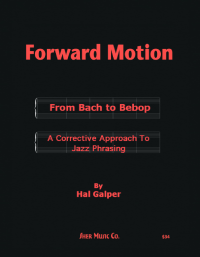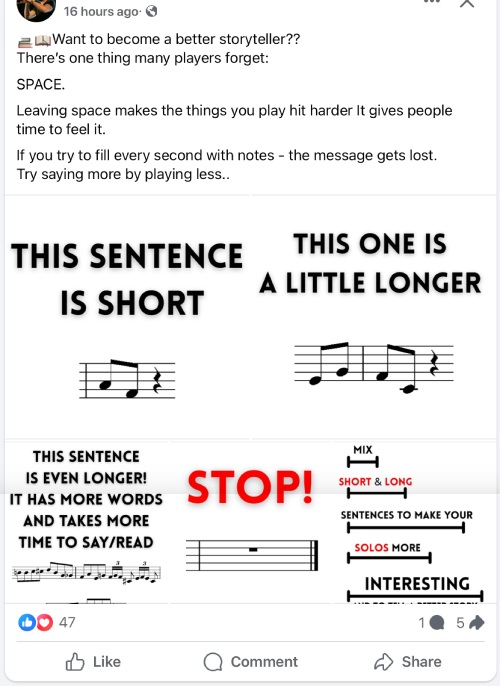
Many guitar methods take an agnostic approach to ‘unlocking' the fretboard or achieving ‘fretboard freedom,' relying on CAGED shapes, scales, triads, arpeggios, and other pattern-based exercises.
These methods aren't necessarily bad. The problem is the assumption that once you've learned the fretboard and the theory, you'll somehow "just know" how to create music, a melody, a chord progression, or how to improvise a solo.
It's the same flawed logic used in college language classes: “If I teach you all the grammar and vocabulary, you'll be able to speak fluently in any social situation.
And again… that isn't necessarily bad! Grammar, conjugation rules, and vocabulary are important. But most people want to learn a second language so they can actually communicate - maybe even with someone they're interested in.
There's a purpose behind learning a second language — connection. Grammar is not the end goal. Neither is fretboard knowledge. Melody is the goal.
I know all the shapes… but I still don't know what to play.
They're not bad teachers. They're just academic thinkers.
These programs are a lot like the freshman college course. If they can give you all the rules and raw data (scales, modes, triads, theory, etc.) the assumption is that you'll eventually figure out how to say something musical.
But that's the academic mindset: drill you with grammar homework, and hope that fluency emerges.
But here's the problem: there's often no clear purpose behind their exercises. Many people only last a week or two... and then get bored.
All these YouTube lessons just pile on more patterns. I need to know how to actually make music.
How many unfinished guitar courses are just sitting in your account collecting digital dust?
Both drawing a portrait and crafting a melody are difficult and complex, which is why it's so valuable to learn from teachers who know how to break big things down into simple steps. I learned something from my college art professor that completely transformed how I think about learning... and I want to share it with you.
My art professor taught us that if you want to draw something complex (like a face), you have to start by mastering the fundamentals. In drawing, those fundamentals are simple shapes (circles, triangles, rectangles, etc). If you can draw those well, you can combine them to create something much more complex, like a recognizable face.
In that sense, complexity is a bit of an illusion because you don't learn how to do the complex skill all at once. You learn a set of simple, fundamental skills... and then put them together. The end result is something that feels effortless... and sounds so good that people can't help but pay attention.
I have learned all the chords and barre chords. I can play them easily. But now how to improve? What to learn next? And where to learn? I need help.
So what are the fundamental components of a melody?
There are three: Phrasing, Melodic Shape (also called Contour), and Note Choice.
Just add some space.
This Facebook advertisement (below) is an example of unhelpful, cliché advice.

You've probably heard that suggestion a dozen times and maybe even from teachers you respect. But here's the problem: "just add some space" isn't instruction. It's a description (accurate, yes) of the end product. It's like telling someone to "just be more flavorful" in the kitchen without giving them the ingredients or the technique.
It's helpful advice for people who have never improvised before. But after a while you'll realize..."I'm just guessing when I should add space. And sometimes I feel like it doesn't sound right but I don't know how to fix it."
In the clip below, a professional guitarist demonstrates what a solo "without space" sounds like. But in reality, there is a small segment where he unintentionally added space after the 2nd phrase.
His 2nd phrase ends in an illogical spot (on the 4th beat) and therefore feels awkward. Even though there is "space" right after that phrase, it didn't help his phrasing. "Space" isn't necessarily the problem that needs to be solved. Instead, think about when phrases begin, when they end, and how long they are.
Here is one possible fix (without changing what notes are played). I moved his solo forward so that it leads into the first beat of the backing track instead of waiting until after the song starts. I also positioned his 2nd phrase a little sooner so that his 3rd phrase could come in leading into the third measure.
Phrasing is about thinking how these short musical segments fit with the rhythm of the song. It's not really about "space" even though "space" is often a common result of good phrasing.

The book Forward Motion by Hal Galper was quite eye (or maybe ear?) opening for me. It made me realize I'd never consciously thought about one of the most important aspects of phrasing: when a phrase starts and when it ends.
Great melody writers aren't just “adding space”, they're deliberately starting and ending their phrases in rhythmically meaningful ways. They're playing with the flow of the music, not just on top of it. The natural result is indeed "space". But they aren't thinking about adding in space, they're thinking melodically.
Music is like a conversation.
...
Be a good conversationalist.
...
You've got to have awareness of what's going on around you.
...
Phrasing means the amount of time that you have to put a certain amount of notes in.
...
Just do something soulful.
...
Eventually we have to turn this into music.
So let's see. I'm going to play two clips of music and I want you to listen carefully. What's different between clip A and clip B?
As you can tell, clip A is a short excerpt from Hey Jude by the Beatles.
In Clip B, everything is the same - the melodic shape (contour) and the notes - but the timing has changed.
Instead of starting “Hey” as a pickup on beat 4 like in the original, I've shifted it so it starts right on beat 1.
This is a change in phrasing. Nothing else changed...just when each phrase begins. And that alone makes it feel different. Don't you think?
In an interview with Rick Beato, Billy Strings shared a pivotal moment in his childhood:
“I was trying to count… and I couldn't. So I said, stop — just let me listen. I listened to what he was doing… and I started hearing the melody as a cue. When my dad went [sings phrase], I knew that's my turn to go.”
Billy learned to listen for when phrases begin. This is what all the great musicians learn to instinctively to do. And for whatever reason, nearly all of them don't realize that they are doing it.
Billy Strings learned to follow phrasing cues instinctively... by listening. Many intermediate guitarists, by contrast, are stuck memorizing scales and CAGED shapes without knowing when or why to use a note.
If you don't understand how melody works... if you don't know what makes one group of notes expressive and another forgettable... then all the fretboard knowledge in the world won't help you.
It's like knowing every street name in a city but not knowing where you're trying to go.
The Melody First Method doesn't treat fretboard learning as a set of patterns to memorize. Instead, we treat the fretboard as a musical landscape... one you explore by learning how melody flows across it.
When you understand what makes a melody work, the fretboard stops being a puzzle and starts being a playground.
Instead of just practicing scales, you'll learn to build real, expressive phrases using structured exercises that connect theory, sound, and fingerboard layout in a way that finally makes sense.
I want to know where to play and why… not just memorize patterns.
I've been playing for years, but I still feel like a beginner when it comes to improvising.
I'm overwhelmed by all the theory ... I just want to understand how to make melodies.
I've hit a wall. I need something that connects everything and gets me playing again.
I'm tired of learning more patterns. I want to learn how to be musical.
I sound like someone who knows scales, not someone who makes music.
We don't start with scale shapes, chord/arpeggio shapes, or octaves. We don't start with music theory charts. We start with melody because that's what music actually is.
The Melody First Method is built around a simple idea:
Learn to create melodies first and let that guide your understanding of the fretboard, theory, and technique.
You'll master the fretboard by using it to say something musical. Here's how we do it:
You'll get crystal-clear training on:
You won't just “understand” these concepts. You'll hear them, play them, and internalize them using real music examples and guided exercises.
Instead of learning “all the notes everywhere” (and forgetting them the next week), we focus on a single 4-fret-span position
Most intermediate players do best starting in 5th position. This is where your first finger lands on the 5th fret. It's a familiar zone for many, especially those who've learned the A minor pentatonic scale. Starting here feels empowering and motivating. Forcing players to begin in first position, on the other hand, often feels like starting over from scratch.
Each fretboard position course lasts about 12 weeks. But even the 5th position course will have you expanding your fretboard knowledge in both directions (3rd/4th positions and 6th/7th positions). After completing the 5th position course, I recommend moving to first position, then finally ninth.
With phrasing, contour, note choice, and fretboard clarity under your fingers, you'll:
And best of all? You'll stop asking “What do I play?” and start playing music that feels like you.
You should learn ALL of music theory... and then forget it.
I get where this idea comes from. And I’ve lived it. I had all my keys, scales, triads, 7ths (and more) all memorized from years of saxophone and jazz piano. I was lucky to have teachers at such a young age that showed me how to effeciently memorize all of my chords, chord tones, and scales. Theory does help! BUT! In my experience, it didn’t really help me create solos that I was proud of.
The truth is, knowing theory is not the same as making music.
This method doesn’t ignore theory; it just puts melody first. That means learning how to phrase, how to shape a melodic line, and how to choose notes with intention. Then we bring in theory where it actually helps you express something.
You don’t need to know everything to sound like you know what you’re doing. You just need the right starting point.
By the way! I actually did write a book on theory. It’s called Music Theory and the Fretboard (Level 1), and it’s helped hundreds of guitarists finally make sense of the fundamentals of theory. I co-taught a high school beginner guitar class and I decided to take my lesson plans and turn them into a book. If you're curious, you can find it here:
If you want to finally connect theory to expression...If you’re tired of guessing and want to start making music that sounds like you, then this method is made for you.
Join the waitlist for the full Melody First Method course and be the first to know when enrollment opens.